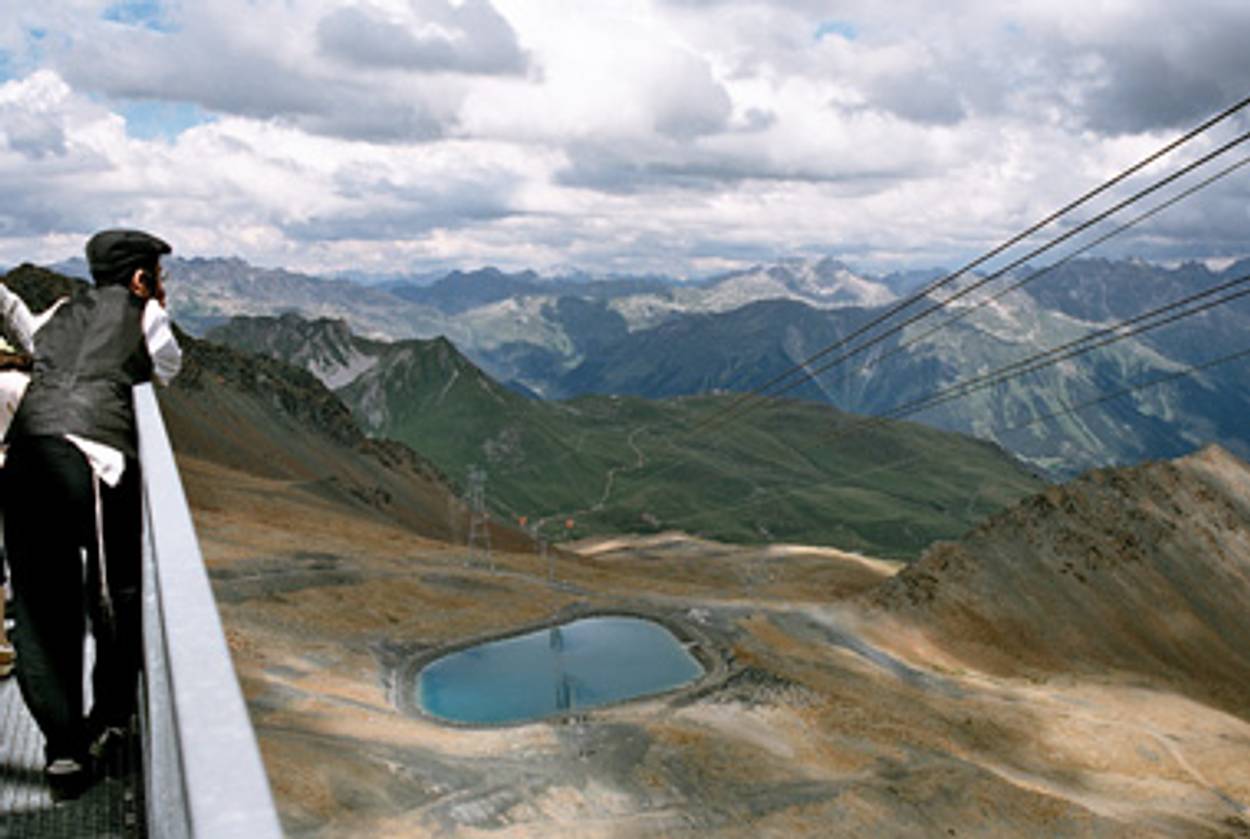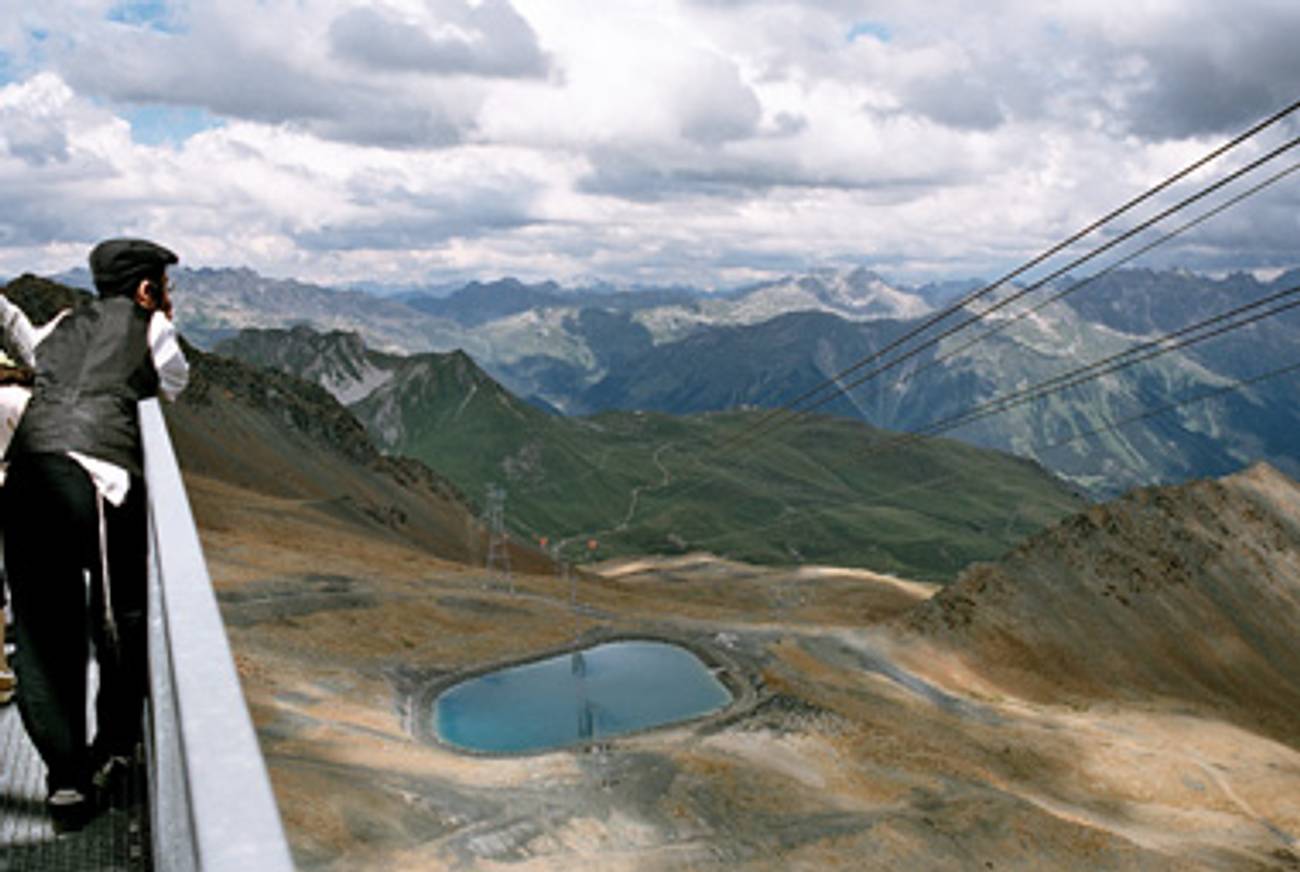Peaks of Perfection
An Austrian museum mounts an exhibition on the Jewish love affair with the Alps




Once upon a time in the Alps, the hills were alive with the sound of Yiddish.
Before the nationalists showed up with their traditional costumes and anti-Semitism, before the Nazis equated the serenity of nature with the purity of race, Europe’s most imperial mountain range was deeply popular with German and Austrian Jews.
They were more than mere tourists. As a new exhibition at the Jewish Museum in Hohenems, Austria, elegantly displays, these 19th- and 20th-century Alpine enthusiasts helped invent skiing, revolutionized climbing, and, in essay after essay, reimagined the Alps as an emblem of universal harmony and eternal grace. “The moment up there at the peak,” wrote Arthur Schnitzler in a typically stirring passage, “this phantasm of belonging together, this immense bliss, probably this was all but ecstasy—mountain ecstasy.”
This Jewish vision of the Alps helped bring into sharp relief the ascent of nationalism in Europe a full decade before Hitler’s rise to power, inspired the fathers of the Zionist movement to cultivate an image of a New Jew—muscular and athletic—and birthed the American-Jewish tradition of summering in the Catskills.
The Nazis, of course, had an entirely different vision in mind. To them, the spate of Mountain Movies—daring tales of Alpine climbing popular in Germany in the 1920s and 1930s—provided a readymade iconography of blue-eyed Aryans beaming in the wuthering heights. Leni Riefenstahl, the Nazis’ masterful documentarian and propagandist, came to Hitler’s attention after directing and starring in the 1932 film The Blue Light a tale of betrayal, redemption, and gorgeous peaks. (The movie, ironically, was co-written and directed by Jewish intellectual Béla Balázs, a fact that Riefenstahl later labored to conceal.)
Sadly, this vision of the mountains as playground for gorgeous gentiles remained strong long after its ideological undertones faded away. Writing in 1959 of a meeting in the Alps between two Jews, the Jewish poet Paul Celan captured this feeling well: “Jew and nature,” he wrote, “these are two different kinds of things, still, even now, even here.”
Hanno Loewy, the Hohenems museum director, largely shared this view until a summer vacation in the Alps a few years ago. “I saw all these Jewish families vacationing in the Alps,” he said, “enjoying themselves in nature, playing on top of the mountain. It’s not what you expect from a vacation in Switzerland.”
Being a curator and a scholar, Loewy quickly came to realize the Alps’ rich Jewish history. It began in the mid-19th century, when developments in modern medicine contributed to a shifting view of the mountains: no longer considered ominous, the Alps, with their clear water and clean air, were perceived as a healthy respite from the cities and their pollutions. From aristocrats to workers, Europeans began flocking to the Alps, creating a need for hotels and restaurants and banks and prompting many entrepreneurial Jews to establish new institutions to serve the eager tourists.
The Jewish contribution, however, wasn’t limited to business development. Enamored with the strange and wild scenery of the Alps, a large group of Jewish adventurers began exploring new sporting opportunities.
First among them was Paul Preuss. A slender man with soft, round features and a doctorate in botany, he was born in a village in the Austrian Alps and compensated for a sickly childhood with an athletic adolescence that revolved mainly around climbing. Unlike the timid sportsmen of the time, Preuss was a daring purist who disdained any artificial aids and saw the rope, the pickaxe, and other standard climbing equipment as hindrances to the symbiotic bond between man and mountain. Before plunging to his death while attempting to scale the Mandelwand mountain in 1913, he completed more than 1,200 Alpine ascents, conquered more than 150 previously unvisited peaks, and became an inspiration for generations of climbers, including Reinhold Messner, considered the greatest mountaineer of all time, who adopted Preuss’s philosophy and became the first man to climb Everest without bottled oxygen, a feat previously thought to be impossible.
Whereas some Jews derived pleasure going uphill, others preferred speeding down slope. In the first years of the 20th century, skiing, still something of a nascent sport, revolved largely around Hannes Schneider, who trained the Austrian army during World War I and starred in many of the early Mountain Movies. Schneider himself wasn’t Jewish, but he drew to him a large and loyal group of Semitic skiers.
Schneider’s strong identification with his Jewish colleagues eventually led to his downfall. “Mister Hannes Schneider may perform his turns wherever he wants,” sneered a Nazi official in 1938. “Perhaps on Mount Sinai, which would suit him best anyway.” Along with some of his colleagues, Schneider fled to the United States, found work in the Catskills, and helped install the artificial snow machine at Grossinger’s.
But the conflict between Jews and their defamers began long before the Nazis marched down the cobblestone streets of Austria and Germany. One of the most fascinating—and chilling—aspects of Jewish Alpinism is that the movement experienced persecution and censure more than a decade before the Nuremberg Laws took effect. In 1921, the Austrian Alpine Association—a body of 6,000 mountain enthusiasts that was previously largely unburdened by anti-Semitism—passed an “Aryan Clause.” One-third of the association’s members, 2,000 people, were Jewish; despite their protests, they were expelled. The German Alpine Association, closely affiliated with its Austrian counterpart, was pressured to pass a similar clause. Not nearly as anti-Semitic as their neighbors to the southeast, the Germans felt uncomfortable with total Aryanization. But not wishing to split the federation in two, they reached a compromise, implementing no specific clause but nonetheless throwing out the association’s overtly Jewish faction.
This seemingly unimportant scuffle, Loewy said, can be seen as an important symbolic step on the path to Hitler’s victory. “I don’t know if history would have taken another turn if the German Alpine Association resisted,” he said, “but they had a choice. What would have happened to the whole of German society if the German Alpine clubs would have resisted? Who knows?”
While subscribers to theories of racial purity were doing their best to curb Jewish life on the mountains, another small and ideologically committed group turned the Alps into a sacred site for budding national consciousness. An enthusiastic Alpinist, Theodor Herzl took his family for annual vacations in the mountains, where he took to bicycling with his characteristic zeal. Hebrew cyclists, he wrote in the late 1890s, represent a new kind of Jew, fit and trim and robust. This, he wrote, was “a magnificent process of transformation, a historic one if you don’t mind! … A few years ago that would have been considered a crazy statement. And again, in a few years, everybody will consider it to be a matter of course.” Similarly, Max Nordau, one of Zionism’s founding fathers, saw the Jews engaging in Alpine sports as the quintessential representatives of his notion of “muscular Judaism,” and rejoiced in seeing Jewish athletes setting up training camps on the mountaintops.
These groups, some associated with strictly Jewish organizations like Hakoah and others belonging to German associations like the Wandervogel, a popular youth movement founded in 1896, also had a tremendous affect on those Jews who migrated to Palestine and later helped found the Jewish state.
In an article reprinted in the exhibition’s catalogue, Israeli historian Yosefa Loshitzky addresses the enchantment of Israel’s founders with all things Alpine. “This Eurocentrism,” she writes, “was massively implemented by the Keren Kayemet LeYisrael (the Jewish National Fund) which since its inception in 1901 has planted over 240 million pine trees in the mountain areas of historical Palestine in an attempt to turn the Holy Land into Switzerland (one of its parks in the Carmel Mountain is even called ‘Little Switzerland’).” Herself having fantasized, as a child, about the mountains as a pristine reprieve from Israel’s muggy climate and chaotic social dynamic, Loshitzky is candid about the ideological implications of her girlhood daydreams: “Ironically, what I have considered to be my own unique escape fantasy was, ultimately, an expression of Eurocentrist ambivalence that was embedded in the Zionist project from its semi-Orientalist beginning. My dreaming of the Alps on the Tel Aviv shore of the Mediterranean was the return of the repressed.”
The Alpine beckoning was never quite as complex for American Jews. Rather than a layered mess of identity and representation, the Jewish infatuation with the Alps migrated to America with little baggage. Unlike Austria and Switzerland, Loewy said, New York was heavily Jewish, and when the city’s population began emulating its European counterparts and seeking solace in summer in the cool mountainous air, a network of largely Jewish hotels and resorts began welcoming hordes of largely Jewish vacationers, christening the Catskills, only somewhat ironically, as “the Jewish Alps.”
With its wealth of historical detail, telling anecdotes, and gorgeous photographs, the Hohenems exhibit, however, suggests that the Alps themselves were the true Jewish Alps, a landscape that shaped and informed so much of modern Jewish history. Samson Raphael Hirsch, the father of modern Orthodoxy, may have best captured this sentiment: “When I shall stand before G-d,” he wrote in the 1880s, “the Eternal One will ask me: Did you see my Alps?”
“Did you see my Alps?”—A Jewish Love Story runs until October 4, 2009, at the Jewish Museum in Hohenems.
Liel Leibovitz is a senior writer for Tablet Magazine and a host of the Unorthodox podcast.
Liel Leibovitz is editor-at-large for Tablet Magazine and a host of its weekly culture podcast Unorthodox and daily Talmud podcast Take One. He is the editor of Zionism: The Tablet Guide.